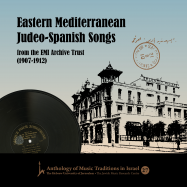(326 results found)
08 Jacob Algava, Venid venid vos contaré
… … Ladino, Ladino - Judeo-Espagnol - Judizmo, Ladino Songs, Ladino - Judeo-Espanol - Judizmo, Ladino - Judeo-Espanol - Judezmo ,Judeo-Spanish … Ladino Songs … Ottoman Empire … Judeo-Spanish - Ladino … Sephardic music … 08 Jacob Algava, Venid venid vos contaré …
07 Jacob Algava, Una cierta hija
… … Ladino, Ladino - Judeo-Espagnol - Judizmo, Ladino Songs, Ladino - Judeo-Espanol - Judizmo, Ladino - … - Judezmo ,Judeo-Spanish … Judeo-Spanish - Ladino … Ladino Songs … Ottoman Empire … Sephardic song … 07 Jacob Algava, Una cierta hija …
06 Jacob Algava, Cantiga de Hanum Dudún
… … Ladino, Ladino - Judeo-Espagnol - Judizmo, Ladino Songs, Ladino - Judeo-Espanol - Judizmo, Ladino - … - Judezmo ,Judeo-Spanish … Judeo-Spanish - Ladino … Ladino Songs … Ottoman Empire … Sephardic music … 06 Jacob Algava, Cantiga de Hanum Dudún …
05 Jacob Algava, Madame Gaspar
… … Ladino, Ladino - Judeo-Espagnol - Judizmo, Ladino Songs, Ladino - Judeo-Espanol - Judizmo, Ladino - … - Judezmo ,Judeo-Spanish … Judeo-Spanish - Ladino … Ladino Songs … Ottoman Empire … Sephardic music … 05 Jacob Algava, Madame Gaspar …
04 Jacob Algava, La constitución se dió
… … Ladino, Ladino - Judeo-Espagnol - Judizmo, Ladino Songs, Ladino - Judeo-Espanol - Judizmo, Ladino - … - Judezmo ,Judeo-Spanish … Judeo-Spanish - Ladino … Ladino Songs … Ottoman Empire … Sephardic song … 04 Jacob Algava, La constitución se dió …
03 Jacob Algava, Hermanos mis queridos
… … Ladino, Ladino - Judeo-Espagnol - Judizmo, Ladino Songs, Ladino - Judeo-Espanol - Judizmo, Ladino - … - Judezmo ,Judeo-Spanish … Judeo-Spanish - Ladino … Ladino Songs … Ottoman Empire … Sephardic song … 03 Jacob Algava, Hermanos mis queridos …
02 Jacob Algava, Grande displacer me haces
… … Ladino, Ladino - Judeo-Espagnol - Judizmo, Ladino Songs, Ladino - Judeo-Espanol - Judizmo, Ladino - … - Judezmo ,Judeo-Spanish … Judeo-Spanish - Ladino … Ladino Songs … Ottoman Empire … Sephardic music … 02 Jacob Algava, Grande displacer me haces …
01 Jacob Algava, Los árboles de almendra
… … Ladino, Ladino - Judeo-Espagnol - Judizmo, Ladino Songs, Ladino - Judeo-Espanol - Judizmo, Ladino - … - Judezmo ,Judeo-Spanish … Judeo-Spanish - Ladino … Ladino Songs … Ottoman Empire … Sephardic music … 01 Jacob Algava, Los árboles de almendra …
53. La doncella esclareciente (Albert Pessah)
… … 10 … 7 … 40889 … Eastern Mediterranean Judeo-Spanish Songs from the EMI Archive Trust (1907-1912) … Ladino, Ladino - Judeo-Espagnol - Judizmo, Ladino Songs, Ladino - Judeo-Espanol - Judizmo, Ladino - … … Judeo-Spanish - Ladino … Ladino Songs … Ottoman Empire … Sephardic music … Salonica … Saloniki … Thessaloniki … …
25. El padre Mercader + El cuerpo de la mujer (CES)
… version under the title Ah Sarica bré (Odeon 54238). The song was widely documented in fieldwork from singers … with similes inspired by natural elements adopted from a song known in the literature as El cuerpo de la mujer or Las … … Judeo-Spanish - Ladino … Ladino Songs … Ottoman Empire … Sephardic music … Salonica … Saloniki … Thessaloniki … …



